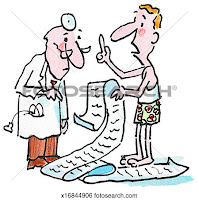The premise that storytelling plays an important role in
patient care arises from our commitment to obtaining a complete and accurate
medical history. The important components include:
·
the history of the present illness (HPI)
including the onset, duration and severity of symptoms
·
the past medical history (PMH) including
previous illnesses and hospitalizations for everything from trauma to surgery
to depression
·
the family history (FH) of serious medical conditions
that have a tendency to run in families (for example, certain cancers,
hypertension, diabetes, heart disease, etc.), genetic tendencies, even mental
health issues
·
the social history (SH) including smoking,
alcohol and drug abuse, cultural and socioeconomic factors, employment, as well
as diet and exercise
There was a time (Yes, I am old
enough to remember it.) when physicians actually took the time to ask about
these matters. They observed the patient tearing up as she recounted her
mother’s battle with breast cancer and the panic she felt when her own breast
started to ache. They noted the moment of hesitation just before the patient
lied about his sexual activity or substance abuse. They connected the patient’s
obesity with his shortness of breath because it was visible to them.
Nowadays, the patient records his
history on a checklist along with his demographics and insurance information.
 |
| www.pixabay.com |
The physician barely has time to inquire about the time of day much less
explore the full spectrum of the patient’s symptoms, much less his lifestyle,
much less his emotional response to what is happening to him…all of which
impact the provider’s ability to make an accurate diagnosis, develop an
effective treatment plan and help the patient heal.
True Story:
The patient was a
twenty-three-year old woman who presented as a “walk in” (meaning she arrived
at the office without an appointment because she had an urgent problem) on a
day when the schedule was already booked and I was running late, as usual. She
had a black eye, but there was more to it than that.
She told me she had been
jumping on the bed (Really? A twenty-three year old??) when she lost her
balance, fell and struck the corner of the nightstand, but there was more to it
than that. Her boyfriend was kind enough to bring her to the office, but that’s
not all he did.
 |
| www.slideshare.com |
The patient had a blow-out fracture of the right orbit (meaning a fracture in the bone that surrounds the eyeball). She needed immediate evaluation and treatment by a skilled specialist. As I was making preparations for her transfer to the ER, I asked her one question: “What really happened?”
It was no surprise to me when she confided that her injuries were caused by a blow from her boyfriend’s fist. She shook with fear as she told me this wasn’t the first time something like this had happened. She felt like she had nowhere to turn.
Besides emergency medical treatment, she desperately needed social services—a safe place to live, a PFA order, someone to stay with her during recuperation. Oh…and she was uninsured. She would definitely need help with the bills.
A single question uncovered a flood of life changing issues for the patient. It was a question you won’t find on any checklist anywhere.
The point is that the importance of storytelling in medicine cannot be overstated.
The question is: “Are you willing to listen?”
jan


No comments:
Post a Comment